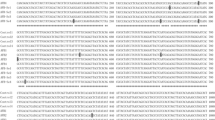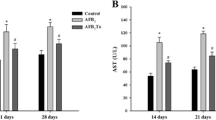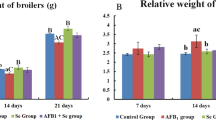Abstract
To investigate the protection of selenium on hepatic mitochondrial functions, 90 7-day-old ducklings were randomly divided into three groups (groups I–III). Group I was used as a blank control. Group II was administered with aflatoxin B1 (0.1 mg/kg body weight). Group III was administered with aflatoxin B1 (0.1 mg/kg body weight) plus selenium (sodium selenite, 1 mg/kg body weight). All treatments were given once daily for 21 days. The results showed that the activities of hepatic mitochondrial complexes I–IV in group II ducklings significantly decreased when compared with group I (P < 0.01). Furthermore, the activities of hepatic mitochondrial complexes I–IV in group III significantly increased when compared with group II (P < 0.05). The hepatic mitochondrial respiratory control ratio (RCR) in group II ducklings significantly decreased when compared with group I (P < 0.01). In addition, the hepatic mitochondrial RCR in group III significantly increased when compared with group II (P < 0.05). These results revealed that the aflatoxin B1 significantly induced hepatic mitochondrial dysfunction in the activities of hepatic mitochondrial respiratory chain complexes I–IV and the RCR in ducklings. However, sodium selenite could significantly ameliorate the negative effect induced by aflatoxin B1.
Similar content being viewed by others
References
Wilson DM, Payne GA (1994) Factors affecting Aspergillus flavus group infection and aflatoxin contamination of crops. In: Eaton DL, Groopman JD (eds) The toxicology of aflatoxins, 1st edn. Academic, San Diego, pp 123–145
Adav SS, Godinwar SP (1997) Effects of aflatoxin B1 on liver microsomal enzymes in different strains of chickens. Comp Biochem Physiol C Pharmacol Toxicol Endocrinol 118:185–189
Hamilton PB (1978) Fallacies in our understanding of mycotoxins. J Food Prot 41:404–408
Essigmann JM, Croy RG, Bennett RA, Wogan GN (1982) Metabolic activation of aflatoxin B1: patterns of DNA adduct formation, removal and excretion in relation to carcinogenesis. Drug Metab Rev 13:581–602
Pederson PL (1978) Tumor mitochondria and bioenergetics of cancer cells. Prog Exp Tumor Res 22:190–274
Garner RC (1980) Carcinogenesis by fungal products. Br Med Bull 36:47–52
Sajan MP, Satav JG, Bhattacharya RK (1995) Activity of some respiratory enzymes and cytochrome contents in rat hepatic mitochondria following aflatoxin B1 administration. Toxicol Lett 80:55–60
Williams GM, Tanaka T, Maeura Y (1986) Dose-related inhibition of aflatoxin B1 induced hepatocarcinogenesis by the phenolic antioxidants, butylated hydroxyanisole and butylated hydroxytoluene. Carcinogenesis 7:1043–1050
Nyandieka HS, Wakhis J, Kilonzo MM (1990) Association of reduction of AFB1-induced liver tumours by antioxidants with increased activity of microsomal enzymes. Indian J Med Res 92:332–336
Shen HM, Shi CY, Lee HP, Ong CN (1994) Aflatoxin B1-induced lipid peroxidation in rat liver. Toxicol Appl Pharmacol 127:145–150
Tang Z, Iqbal M, Cawthon D, Bottje WG (2002) Heart and breast muscle mitochondrial dysfunction in pulmonary hypertension syndrome in broilers (Gallus domesticus). Comp Biochem Physiol A Mol Integr Physiol 132:527–540
Bradford HF, Dodd PR (1977) Convulsions and activation of epileptic foci induced by monosodium glutamate and related compounds. Biochem Pharmacol 26:253–254
Zhang S, Fu J, Zhou Z (2004) In vitro effect of manganese chloride exposure on reactive oxygen species generation and respiratory chain complexes activities of mitochondria isolated from rat brain. Toxicol In Vitro 18:71–77
Wogan GN (1999) Aflatoxin as a human carcinogen. Hepatology 30:573–575
Sharma RA, Farmer PB (2004) Biological relevance of adduct detection to the chemoprevention of cancer. Clin Cancer Res 10:4901–4912
Klein PJ, Van Vleet TR, Hall JO, Coulombe RA Jr (2002) Biochemical factors underlying the age-related sensitivity of turkeys to aflatoxin B(1). Comp Biochem Physiol C Toxicol Pharmacol 132:193–201
Preston RJ, Williams GM (2005) DNA-reactive carcinogens: mode of action and human cancer hazard. Crit Rev Toxicol 35:673–683
Seyfried TN, Shelton LM (2010) Cancer as a metabolic disease. Nutr Metab (Lond) 7:7–28
Ebringer L (1990) Interaction of drugs with extranuclear genetic elements and its consequences. Teratog Carcinog Mutagen 10:477–501
Pedersen PL, Greenawalt JW, Reynafarje B, Hullihen J, Decker GL, Soper JW, Bustamente E (1978) Preparation and characterization of mitochondria and submitochondrial particles of rat liver and liver-derived tissues. Methods Cell Biol 20:411–481
Sajan MP, Satav JG, Bhattacharya RK (1997) Effect of aflatoxin B in vitro on rat liver mitochondrial respiratory functions. Indian J Exp Biol 35:1187–1190
Sajan MP, Satav JG, Bhattacharya RK (1996) Alteration of energy-linked functions in rat hepatic mitochondria following aflatoxin B1 administration. J Biochem Toxicol 11:235–241
Towner RA, Qian SY, Kadiiska MB, Mason RP (2003) In vivo identification of aflatoxin-induced free radicals in rat bile. Free Radic Biol Med 35:1330–1340
Sohn DH, Kim YC, Oh SH, Park EJ, Li X, Lee BH (2003) Hepatoprotective and free radical scavenging effects of Nelumbo nucifera. Phytomedicine 10:165–169
Berg D, Youdim MB, Riederer P (2004) Redox imbalance. Cell Tissue Res 318:201–213
Janssen YM, Van Houten B, Borm PJ, Mossman BT (1993) Cell and tissue responses to oxidative damage. Lab Invest 69:261–274
Acknowledgments
This work was supported by the National Natural Science Foundation of China (grant no. 38071900).
Author information
Authors and Affiliations
Corresponding author
Additional information
Dayou Shi, Shining Guo, and Shenquan Liao contributed equally to this work.
Rights and permissions
About this article
Cite this article
Shi, D., Guo, S., Liao, S. et al. Protection of Selenium on Hepatic Mitochondrial Respiratory Control Ratio and Respiratory Chain Complex Activities in Ducklings Intoxicated with Aflatoxin B1 . Biol Trace Elem Res 145, 312–317 (2012). https://doi.org/10.1007/s12011-011-9195-6
Received:
Accepted:
Published:
Issue Date:
DOI: https://doi.org/10.1007/s12011-011-9195-6




